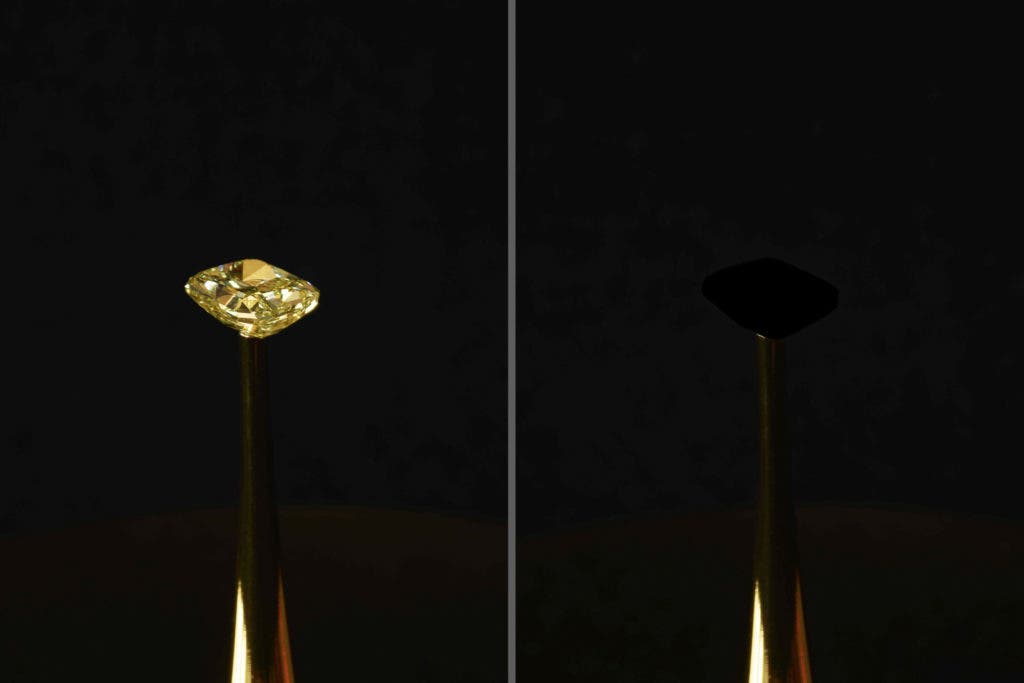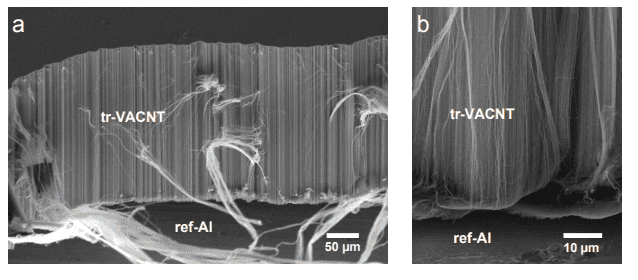The material is made from vertically aligned carbon nanotubes and absorbs 99.996% of any incoming light — making it the darkest material on record by a long shot.

In 2014, Vantablack officially hit the market as the darkest material on Earth. But, in a move that would definitely make Leonard Cohen proud, researchers have gone even further, using a “forest” of carbon nanotubes that makes light lose its way.
However, the material was made by accident. The team was trying to find a way to produce carbon nanotubes on an aluminium foil. These foils oxidate quite quickly in air, and this is a big problem, because the oxide layer acts as an insulator, blocking electricity and heat.
To ensure that the foil doesn’t oxidate, the team soaked it in saltwater, and then moved it around in an oxygen-free environment. They also experimented with other common products, such as detergent or baking soda, but saltwater proved to be the most effective at preventing oxidation.
They then placed the etched aluminum in an oven, where they used a process called chemical vapor deposition to grow carbon nanotubes on it. The material had improved its thermal and electrical properties, something which the team expected.
But something else stood out: it was really, really black.
“I remember noticing how black it was before growing carbon nanotubes on it, and then after growth, it looked even darker,” says former MIT postdoc Kehang Cui, now a professor at Shanghai Jiao Tong University, who led the study. “So I thought I should measure the optical reflectance of the sample.”

It makes a lot of sense for the material to be dark. The key behind Vantablack and other extremely dark materials is carbon nanotubes. If the material contains bumps, ridges, or any other features, light bounces around these features and doesn’t get reflected back. If you build a “forest” of such tubes, you basically create a maze from which light just can’t escape. This is also the reason why you can’t really “paint” anything Vantablack — you need to use chemical vapor deposition for the carbon nanotubes.
However, while researchers were expecting the material to be black, it just looked too black. Cui measured its optical properties and was stunned: no matter where you look at it, from every possible angle, the material absorbed more than 99.995% of incoming light.
Luckily for Cui, artist Diemut Strebe was working with MIT at the time. He had access to a 16.78-carat natural yellow diamond, estimated to be worth $2 million. As any reasonable people would do, Cui and Strebe thought of one thing: let’s cover the diamond with the black material and see what happens. The effect is striking: the diamond, which is normally shiny and vibrant, appears as a dark void.
“Our group does not usually focus on optical properties of materials, but this work was going on at the same time as our art-science collaborations with Diemut, so art influenced science in this case,” says Brian Wardle, professor of aeronautics and astronautics at MIT, who was also involved in the study.
This is often the case with these darker-than-life materials — images don’t do them justice, because it almost feels like you’re looking at a picture of nothing.
However, it’s not just an aesthetic challenge. Extremely black materials have important technological uses, from preventing stray light from entering telescopes to improving the performance of infrared cameras.
“There are optical and space science applications for very black materials, and of course, artists have been interested in black, going back well before the Renaissance,” says Wardle. “Our material is 10 times blacker than anything that’s ever been reported, but I think the blackest black is a constantly moving target. Someone will find a blacker material, and eventually we’ll understand all the underlying mechanisms, and will be able to properly engineer the ultimate black.”
It’s not exactly clear what is making this new material so much more darker than previous substances such as Vantablack, but researchers suspect it has something to do with the combination of etched aluminium (which is already pretty dark) to the carbon nanotubes.
We should expect even darker materials to come, researchers say.
“CNT forests of different varieties are known to be extremely black, but there is a lack of mechanistic understanding as to why this material is the blackest. That needs further study,” Wardle concludes.
The study has been published in the journal ACS Applied Materials and Interfaces.



